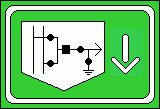Measuring transformers:
In a substation are big voltage and current values, we can't measure them directly, we bave to build in devices witch make indirect harmonic values, they are 1 A and 200 V nominal values on the most substations.
Two secondary device types use the secondary measuring circuits: the mesuring devices (all measurings) and the relay devices (protections). One measuring transformer has more secondary colis (cores). There are two types
od measuring transformers: paper-oil or SF6 gas insulated. The small indoor measuring transformers are in epoxy coat. There are exist combinated measuring transformers, one device has current and voltage cores too.
Current transformer:
The current transformer makes 1 A from 1000 A or 2000 A or from somemany wat you want. Because of the big transformation and the big primary currents the primary coil is one rod, on round of that rod is the scondary coil. The primary current has to flow cross the measuring transformer.
The secondary devices are in serial in the current measuring circuits.
A current measuring circuit is grounded in one point because the circuit's voltage can lift up. The current measuring core is alike than a current generator, it keeps the actual current value. If the measuring circuit opens, the core
lifts up the voltage and it can make hard sparks or the measuring transformer can blows up. If you want service a secondaty device, you have to put a short circuit onto the core. (That is similar than the big and small cog wheels, if you stop the hard big one, it breaks the driver small fast one)
Voltage transformer:
That is an easy tranformer, it's cores give only voltage for measuring and for relays. They are simple circuits with fuses. One secondary device has one fused voltage circuit. Two types of voltage measuring circuits exist: the either grounds the
star point (neautral), and the second one grounds the L2 phase (L1 and L3 are on line voltage, the neutral is on phase voltage, the L2 is on ground). The voltage transformer measures the primary phase voltage from the ground.
A 400 kV field sevtion: Forking devices
|
|







